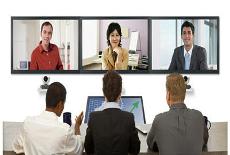
Video conferencing is fast becoming one of the must-haves for businesses. By eliminating travel from the equation, companies can now look forward to reduced travel costs. That doesn’t just mean train or plane tickets. It also includes other expenses associated with travel such as food allowance, venue fees, and nightly accommodations. In the age of video solutions, though, companies can finally say goodbye to those costs. Instead of long-distance travel, employees can now sit behind their desks and meet up with team members from different branches or sites, no matter if that site happens to be in another city, state, or continent.
However, before you can take advantage of those benefits, you’ll need to make sure you pick out the right system first. Here are the top three essential features you need to check before you say yes to a multimedia communication solution. If you have this in the bag, then you’re good to go:
- Collaboration-Ready Features
While the slashed travel time is certainly one of the good things about video conferencing, it’s not the best benefit out there. Collaboration-ready features take up that spot. Why? BBC says that by the year 2025, millennials will make up about 75 percent of the global workforce. Millennials share a drastically different perception of how work is supposed to be. They want greater flexibility at work. They want more life-work balance. That’s not going to happen if they need to be at the office, tied to their desks from nine to five. With flexible work from home policies and arrangements, millennials are much more motivated to work. But the Harvard Business Review says that flexibility isn’t the only driving force. One way to encourage peak productivity in millennials is for companies to embrace technology and make collaboration an integral part of the business. That’s where video solutions come in. They not only make it possible for millennials to work from home and spend more time with their loved ones, but they also improve collaboration in teams which helps keep team work and camaraderie strong. In an age where more and more employees are working on remote, with some teams working in geographically dispersed areas, a tool that helps you build your team while giving them free rein is the best kind of system to invest in.
- Video Display
Face to face contact is often a few notches higher than email, calls, and text. That’s because, unlike non-visual ways of communication, video offers you a way to get a clear and often accurate insight into what the other party is thinking about. That’s because body language helps you get a solid gauge on what your team mates are thinking, no matter if they’re onsite or in another continent. That’s why another feature you should take a long look at is the display. Face to face contact is the edge this technology has over other kinds. If the display is blurry, then it’s not going to be enough to provide you and your team with the necessary support you need to get things done. That’s where video conferencing services from BlueJeans comes in. With HD resolution, you won’t have any problems seeing eye to eye with everyone on your team. High resolution makes it seem like your offsite employees are just right there beside you, so make sure to check the display quality before you decide on anything. Aside from face to face contact, it also makes it easy to collaborate and work together on projects—from sharing content to reviewing project revisions and updates—with a high resolution output.
- Multipoint Compatibility
Lastly, be sure to ask about multipoint compatibility. That basically means your system is well able to work from different devices and platforms. If you need to get to a meeting and you’re stuck in traffic, you can log on and go to the meeting online, all without having to leave that parking slot or get out of traffic. What if your laptop is dead? No worries. Because of the multipoint feature, you can access that meeting on your mobile phone or tablet while the rest of your team is onsite and using the conferencing equipment or camera back at the office. That kind of flexibility means you can easily and seamlessly shift devices when you conduct your meetings, depending on what arrangement works best for you at the moment. No need to be tied down to one unit or device for your conferences to work. That way, you can shift to video communication anywhere, anytime.
Knowing what features are essential to an excellent system is key to picking out one that’s ideal for your business. Take a minute to think long and hard on these features. As long as the system you choose has these in the bag, you’ll be fine.
Related posts:






